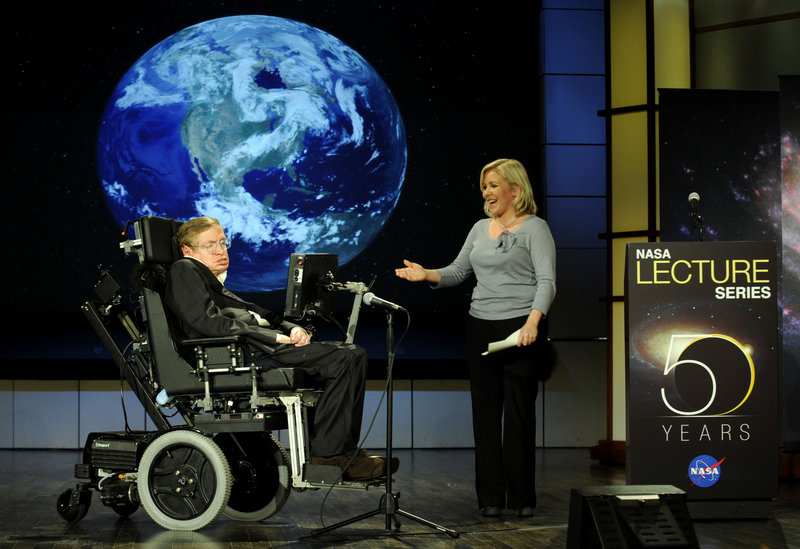CAMBRIDGE, England – British scientist Stephen Hawking has decoded some of the most puzzling mysteries of the universe but he has left one mystery unsolved: How he has managed to survive so long with such a crippling disease.
The physicist and cosmologist was diagnosed with Lou Gehrig’s disease when he was a 21-year-old student at Cambridge University. Most people die within a few years of the diagnosis, called “motor neurone disease” in the U.K. On Sunday, Hawking will turn 70.
“I don’t know of anyone who’s survived this long,” said Ammar Al-Chalabi, director of the Motor Neurone Disease Care and Research Centre at King’s College London. Al-Chalabi, who does not treat Hawking, described his longevity as “extraordinary.”
“It is unusual for (Lou Gehrig’s disease) patients to survive for decades, but not unheard-of,” said Dr. Rup Tandan, a neurology professor at the University of Vermont College of Medicine. Still, Tandan said many longtime survivors had ventilators to breathe for them — which Hawking does not.
Hawking first gained attention with his 1988 book “A Brief History of Time,” a simplified overview of the universe. It sold more than 10 million copies worldwide. His subsequent theories have revolutionized modern understanding of concepts like black holes and the Big Bang theory of how the universe began.
To mark his birthday Sunday, Cambridge University is holding a public symposium on “The State of the Universe,” featuring talks from 27 leading scientists, including Hawking himself.
For 30 years, he held a mathematics post at the university previously held by Sir Isaac Newton. Hawking retired from that position in 2009 and is now director of research at the university’s Centre for Theoretical Cosmology.
Hawking achieved all that despite being nearly entirely paralyzed and in a wheelchair since 1970. He now communicates only by twitching his right cheek. Since catching pneumonia in 1985, Hawking has needed around-the-clock care and relies on a computer and voice synthesizer to speak.
A tiny infrared sensor sits on his glasses, hooked up to a computer. The sensor detects Hawking’s cheek pulses, which select words displayed on a computer screen. The chosen words are then spoken by the voice synthesizer. It can take up to 10 minutes for Hawking to formulate a single sentence.
“The only trouble is (the voice synthesizer) gives me an American accent,” the Briton wrote on his website.
It took Hawking four years to write his last book, “The Grand Design,” missing his publisher’s original deadline.
Hawking declined requests from The Associated Press for an interview, but his personal assistant, Judith Croasdell, spoke to the AP. She described her boss as remarkably patient.
“The way he communicates can seem frustratingly slow to most people, but he doesn’t let that impede his thinking,” she said.
After a brief hospital stay, Hawking told Croasdell that he spent the time thinking about black holes.
Hawking typically starts work after a big breakfast and reading the news, she said. “He’s not an early morning person, but he does stay up quite late,” until about 7 or 8 in the evening, she said.
Hawking’s fame has led to guest appearances on some of his favorite television shows, including “The Simpsons” and “Star Trek.” His animated likeness from “The Simpsons” has even been turned into an action figure — one of which sits proudly on his office desk. There’s also a Homer Simpson clock that Hawking is known to glare at when visitors are late for an appointment.
Kitty Ferguson, who’s written two biographies of the physicist, said he has programmed his computer to respond to people who ask if he’s Stephen Hawking. “No, but I’m often mistaken for that man,” his voice synthesizer deadpans.
Hawking says on his website that he tries not to think about his limitations.
“I try to lead as normal a life as possible and not think about my condition or regret the things it prevents me from doing, which are not that many,” he says.
That certainly seems to be the case. Framed photos in his office show the physicist with several popes and on trips to China and Easter Island.
He has even flown in a space simulator. In 2007, Hawking took a zero-gravity flight in Florida, the first time in 40 years he abandoned his wheelchair.
“That was the happiest I’ve ever seen Stephen,” said Sam Blackburn, Hawking’s graduate assistant, who accompanied him on the ride along with about six others, including two doctors. “He just had the biggest grin on his face.”
Hawking has also been married and divorced twice and has three children and three grandchildren.
Al-Chalabi said most patients with Lou Gehrig’s disease die after their breathing muscles stop working. He had no predictions for what the biggest health risks to Hawking’s future might be.
“He is truly remarkable,” Al-Chalabi said. “This is someone who’s managed to find ways around every single problem the disease has thrown at him.”
Send questions/comments to the editors.



Success. Please wait for the page to reload. If the page does not reload within 5 seconds, please refresh the page.
Enter your email and password to access comments.
Hi, to comment on stories you must . This profile is in addition to your subscription and website login.
Already have a commenting profile? .
Invalid username/password.
Please check your email to confirm and complete your registration.
Only subscribers are eligible to post comments. Please subscribe or login first for digital access. Here’s why.
Use the form below to reset your password. When you've submitted your account email, we will send an email with a reset code.